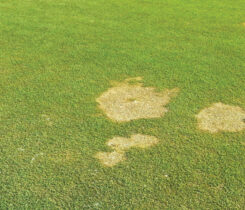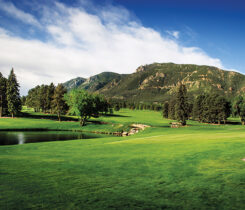100 years young: The USGA Green Section
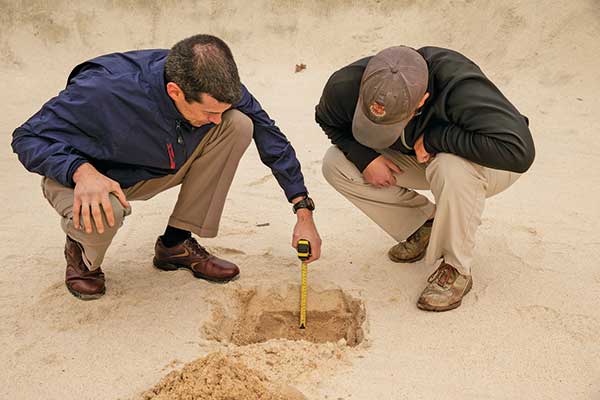
Evaluating bunker locations helped the USGA Green Section in remedying pace-of-play issues that have plagued the industry for so long. (Photo courtesy of the USGA)
When it comes to nonprofit organizations, more than half fail between their first and fifth year of existence. Not so for the 126-year-old United States Golf Association (USGA), which celebrates the centennial of its Green Section this year, despite the survival-of-the-fittest backdrop.
But, alas, there’s barely any time for reflection within USGA’s ranks. While it isn’t totally reinventing itself, the Green Section is busier than ever (and that’s saying something) as it artfully adapts to the industry’s most pressing needs.
“The USGA Green Section has constantly evolved its programs and services to address golf’s ever-changing needs, so it’s in our DNA to continue meeting the challenges of tomorrow,” says Senior Managing Director of Public Services Rand Jerris. “Our willingness and ability to evolve is grounded in a deep sense of purpose to serve the game, the golf courses who are our customers and their collective needs.”
Those collective needs have shifted drastically over the past decade as both public and private golf courses strive to operate more effectively and efficiently with maintenance budgets — and staff — that are under constant pressure to do more with less.
After all, through its unwavering, four-prong mission of research, education, consulting and outreach, no organization has had a more profound impact on the golf experience than this elite group of agronomists and data scientists.
A merger in the making
In 2017, the USGA’s Research, Science and Innovation Group (RSI) rolled out the first version of its “Facility Tool” to help courses with the beleaguering pace-of-play issue that’s haunted the industry for so many years.
Small GPS loggers were placed on golfers at several courses to track their movements on foot and in carts. Movement patterns were overlaid with variables like green speed, rough height and bunker locations. As a result, operators could visualize how these elements impacted the speed at which golfers moved through the course.
Early on, however, the RSI Group discovered a powerful, ancillary benefit: The Facility Tool could also help courses identify underutilized sections of turf that could be removed without affecting play. It was first deployed at Crandon Golf Course in Key Biscayne, Fla., in concert with architect John Sanford, and resulted in a master plan that could ultimately save Crandon $350,000 annually.
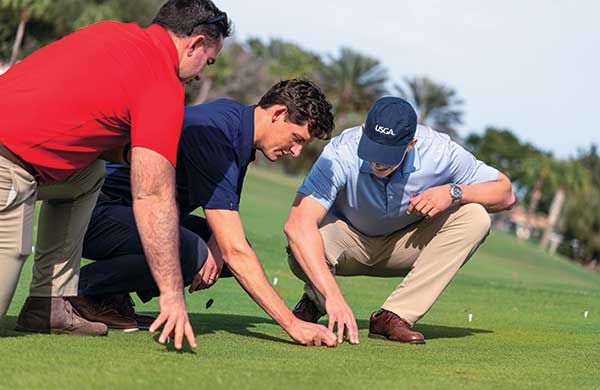
Information provided from USGA research allowed courses to make putting surfaces more consistent. Pictured here: Cole Thompson, Zach Nicoludis, Paul Jacobs. (Photo courtesy of the USGA)
It was this successful foray into turf territory that helped lead to the merger of the Green Section with the RSI Group in the fall of 2019. With this brand-new and expansive platform fortified by data-driven decision-making, the new-look Green Section has leveled up for its next 100-year era.
“We can now provide more sophisticated technology tools to speed and increase the reach of transferring knowledge and expertise into the field,” Jerris says. “We don’t see this as a new direction but rather enhancing and improving our capabilities, so we can deliver even more impact for golf courses for the next 100 years.”
Green Section and RSI Managing Director Matt Pringle adds, “The fall of 2019 really offered us a pause and juncture to reflect on our 100th year of serving the golf industry and to ask ourselves where to go from here. There was a prevailing sentiment around our consulting service that it was too expensive for your average public. That’s not the case, and we needed to change that perception through education and outreach.”
Thinking small
Including multimillion-dollar research projects and major championship preparations, the Green Section has quarterbacked numerous high-profile projects over the years. But, Chris Hartwiger, longtime director of course consulting, believes data-driven “micromodels” that benefit a wide variety of facility types will be a major focus of the section in the coming years.
“It’s not about big data. It is about collecting the right data from facilities that helps them make decisions,” Hartwiger says. “The more courses you have participating in this modeling, the more patterns and trends start to emerge.”
For example, in 2018, Hartwiger and USGA agronomist Addison Barden posed a seemingly simple question: What do good putting surfaces have in common? The answer, as it turned out, was much more complex.
The duo embarked on a project with six courses in the Southeastern U.S. to gain scientific clarity and develop a methodology for superintendents to employ within their existing maintenance budgets. The performance indicators were green speed and clipping volume, while inputs included fertilizer, weather, mowing and rolling.
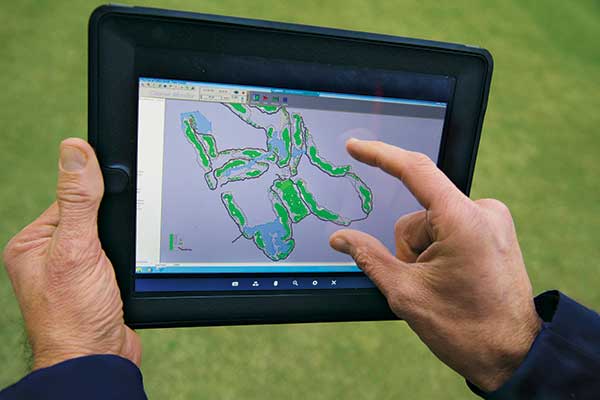
The more courses that participate in modeling, the easier it becomes to identify trends and patterns. (Photo courtesy of the USGA)
“We’re up to 21 courses participating and hope to add more this year,” Hartwiger says. “The charts and graphs help superintendents visualize green performance over time, and spreadsheets allow them to model for different variables. Collectively, the information enables them to provide golfers a more consistent putting surface over time.”
Similarly, the Green Section has developed a model to assist courses with the timing and budgetary impact of aerating greens. Facilities in destination regions, like Myrtle Beach and Hilton Head, S.C., have historically avoided punching putting surfaces anytime close to the spring or fall peak season. While such a practice makes common sense, it doesn’t necessarily make scientific or economic sense.
“Aerating greens in winter months leads to longer recovery time, which can have an even greater effect on revenue,” Hartwiger says. “With the model, a course can enter any date, and it will generate the number of days needed for recovery.”
Forward thinking
Mike Wallace, superintendent at Simsbury Farms Golf Course in West Simsbury, Conn., is working with the Green Section to create a plan for the construction and maintenance of junior tees on all 18 holes. Like many courses, previous junior tees were simply areas cut next to fairways.
“It is our goal to have the junior golfer get the same enjoyment from the round of golf as any adult patron,” Wallace says. “To attain that goal, they need to be treated accordingly and equally.”
Simsbury Farms has built a new forward tee on its fifth hole and hopes to move forward with a full set of junior tees this year as funds become available. The Green Section has been instrumental in helping design tee boxes that can be cut with fairway mowers as they run through each hole in the morning, according to Wallace.
“The topic of forward tees for juniors and especially for women is really going to blow up over the next few years,” Hartwiger says. “Courses that want to grow rounds and memberships should be focused on this right now.”
When asked if there’s a micromodel for plotting the location of these new forward tees, Hartwiger releases a hearty laugh. “Of course,” he says. “It spits out a bar graph of the distance and clubs that women hit into holes. On most courses, they are hitting fairway woods into greens on 14 out of 18 holes. That’s a different game than many of us play and not nearly as enjoyable.”
Holistic approach
If helping facilities improve pace of play and the golf experience for women, juniors and beginners sounds a lot like growing the game of golf, well, that’s exactly the plan. And to do that, the Green Section will look to double-down on its partnerships with other industry organizations.
“I really think a consulting agronomist and golf course architect can be a powerful team to help golf courses,” Pringle says. “There is some overlap, but we are mostly complementary in terms of strategy and services. Finding ways to get both organizations to get to know each other and our services better is a prime objective.”
Jerris also sees public golf courses as being a major emphasis for the Greens Section in the coming years. Approximately 75 percent of the facilities that engage the USGA for consulting are private currently. Not only have private clubs historically had the budget to support it, but they also have the willingness to push the agronomic envelope to keep members satisfied.
“It will be important for the Green Section to continue to evolve its programs, research and services to be more relevant, accessible and affordable for low- to midbudget facilities,” Jerris says. “If you have programs that deliver great impact, you’ll have greater collective influence on the game.”
Keith Hall, owner of The Pointe and Carolina Club golf courses in North Carolina’s Outer Banks, is a prime example of a public course operator who utilizes the full menu of Green Section services. Including consultation on fertilizers and equipment updates and relocating forward tees and turf reduction, Hall has sampled a bit of everything over the past 25 years.
“They are a treasure chest of information and some of the smartest people you will meet in this industry,” Hall says. “They answer all of your questions and provide a written report covering that plus anything else they find on the golf course. You can call or email Chris (Hartwiger) anytime, and he’ll get back to you in short order.”
As the Green Section forges into its next 100 years, one thing is for certain. It has big shoes to fill: its own.









